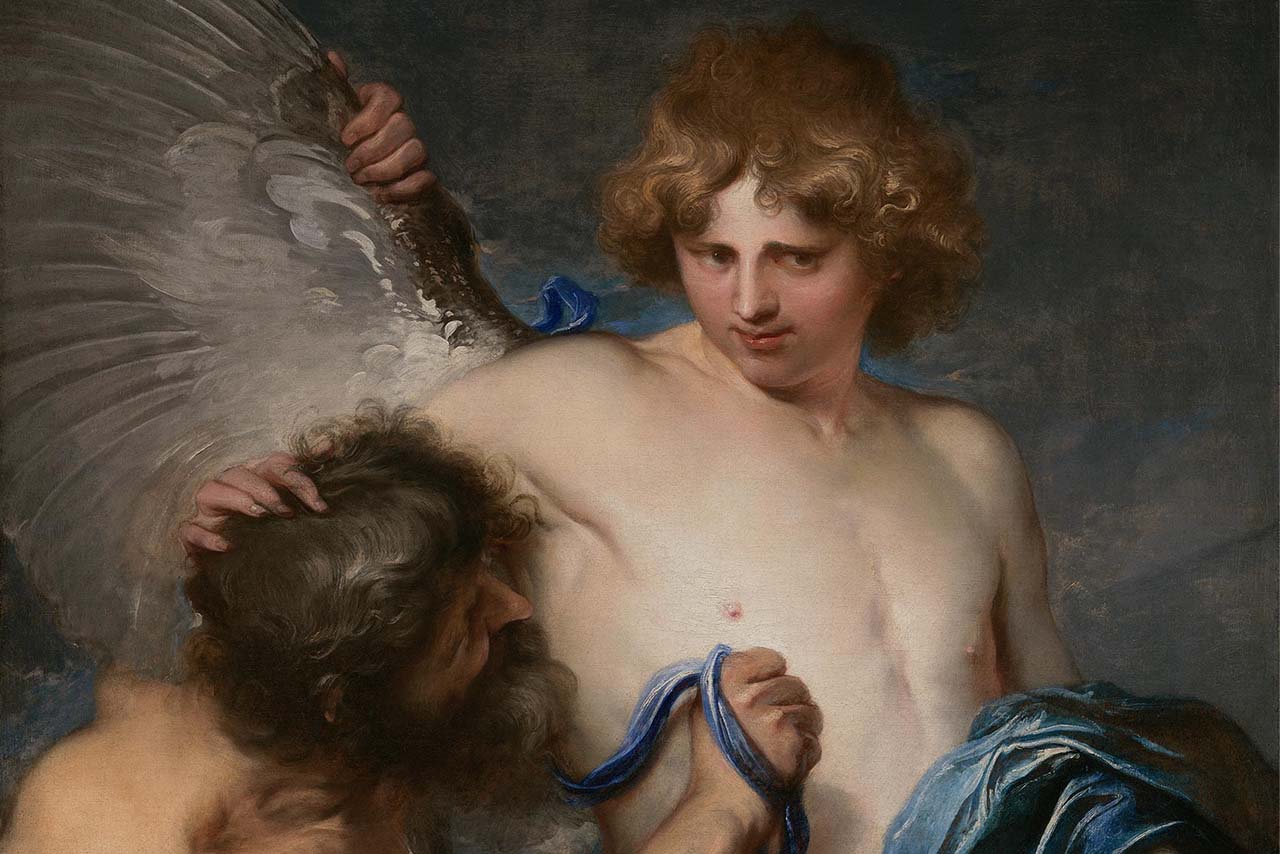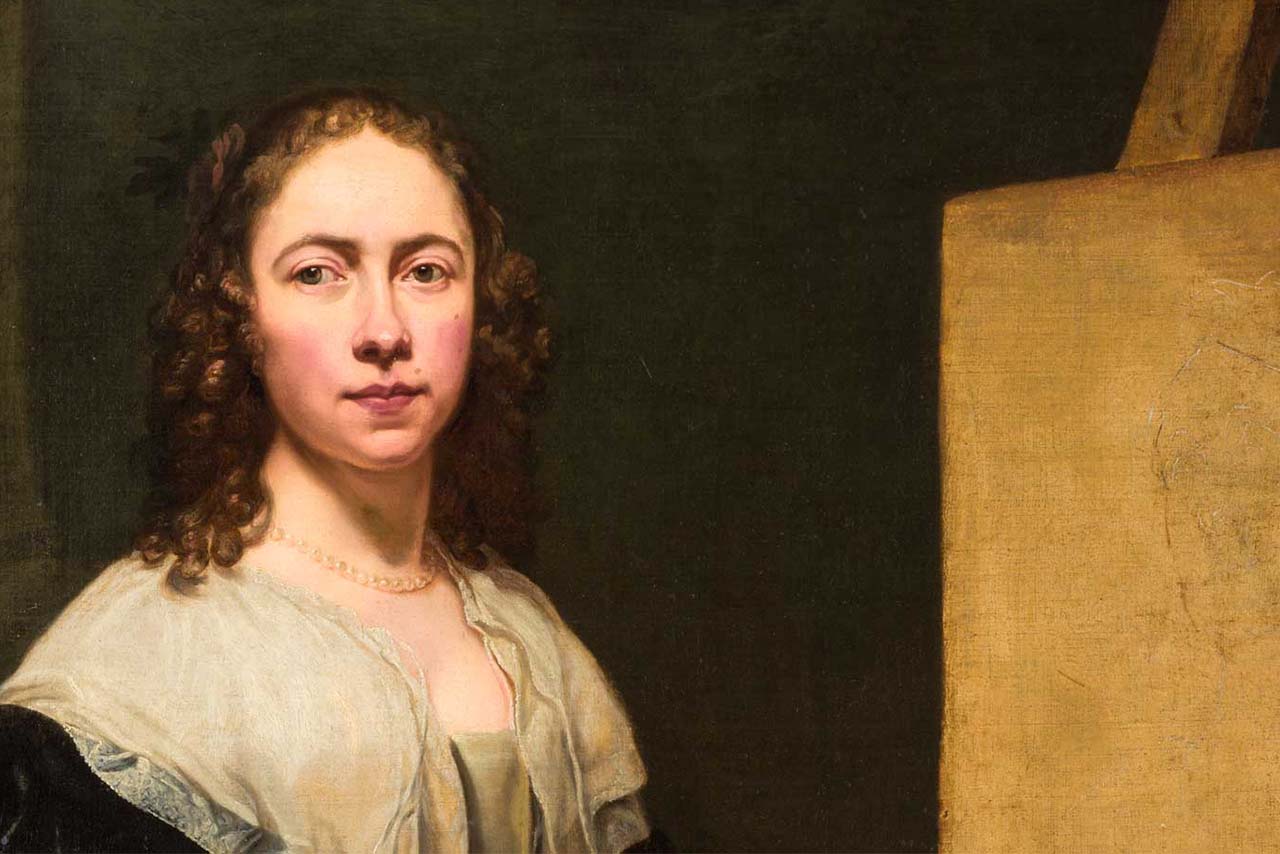Freud argued that much of human behavior arises from unconscious drives, and art serves as an expression of these repressed emotions. His student, Carl Jung developed this idea into a more symbolic and integrative framework. According to Jung, the human psyche consists of three key layers: the persona (the social mask we present to the world), the shadow (the hidden or denied aspects of ourselves), and the self (the unified whole that emerges when these parts come into balance). In many ways, these psychological dynamics were painted by Baroque artists centuries before Jung named them. Their self-portraits were more than just a representation of themselves; they were an attempt to confront their masks, shadows, and inner selves.
Persona: Van Dyck’s Performed Identity
Anthony van Dyck stands as one of the defining painters of the Baroque era. In his early Self-Portrait as Icarus (c.1623), he presents himself as Icarus from Greek mythology. In the myth, Icarus is the son of Daedalus, who crafts wings from feathers and wax so they can escape imprisonment. Daedalus warns his son not to fly too high or too low, yet Icarus soars too close to the sun, the wax melts, and he falls into the sea.
Van Dyck uses this story to shape how we see him. The pose is theatrical, the fabrics shimmer, and every element of the painting is carefully composed. The image becomes an example of persona, which is the mask we wear to meet the world as Jung described it. Van Dyck’s persona is idealized and courtly; ambitious, graceful, and worthy of admiration. At this point in his career, he was still emerging under Rubens’s influence and striving for recognition among aristocratic patrons. By painting himself as the daring Icarus, Van Dyck turns myth into self-mythology, reflecting both ego ambition and social strategy. The Baroque fascination with spectacle and status becomes a psychological mask in this self portrait. It’s a performance of confidence that conceals vulnerability beneath beauty.

Shadow: Rubens’s Calm As A Controlled Storm
Peter Paul Rubens’s Self-Portrait (1639), painted near the end of his life, embodies Jung’s notion of the shadow, which is the unacknowledged or repressed part of the psyche.
Unlike his earlier paintings bursting with energy, sensual color, and movement, this work is marked by composure and restraint. His brushstrokes are calm and his expression is meditative. At first glance, Rubens appears entirely at peace. Yet, beneath this surface serenity lies a different truth. The artist, once Europe’s most vigorous painter and diplomat, was confronting illness, aging, and his own mortality. His calmness feels deliberate, reflecting the discipline of a man who has learned to contain his passions.
In Jungian terms, this quiet dignity signals a reconciliation with the shadow. Rubens’s once untamed vitality became wisdom. The portrait’s tranquility is not emptiness, it is the visible outcome of an inner negotiation and a mature artist mastering his own depth.

The Self: Wautier’s Integration And Authenticity
With her Self-Portrait (c. 1645), Michaelina Wautier vividly illustrates the Jungian concept of the self, which refers to the integrated and authentic whole of one’s self. During a time when women painters were marginalized, Wautier portrays herself at work, brush in hand, meeting the viewer’s gaze directly. There is no theatrical costume, no mythological disguise, there is only honest confrontation.
She exhibits a calm yet confident expression, embodying what Jung described as individuation, the process of integrating the inner and outer worlds. By painting herself not as an object of beauty but as a creator, Wautier asserts authorship, intellect, and self-possession. Her realism rejects the Baroque tendency toward spectacle, offering instead a psychological truth: the artist in the flow of her craft and identity. In Jung’s framework, Wautier achieves what Van Dyck and Rubens only approach, the full integration of persona and shadow into a centered, self-aware being.

Conclusion: The Baroque Mind And The Birth Of Self-Awareness
Through the lenses of Jungian psychology, the Baroque era emerges as a mirror of the human psyche. From performance to confrontation to wholeness, Van Dyck’s shimmering mask, Rubens’s reflective spirit, and Wautier’s grounded authenticity trace the journey of the self from performance to confrontation to wholeness. Long before psychology existed as a science, these artists staged on canvas the balance between how we appear and who we truly are. We are reminded by their portraits that every image we present of ourselves, whether it is painted in oil on canvas or displayed on a screen, reveals not only the face we wish to show, but also the unseen depths we are still learning to understand.
References
Van der Stighelen, K. (Ed.). (2018). Michaelina Wautier, 1604–1689: Glorifying a forgotten talent. MAS Antwerp / Rubenshuis.
Schütte, S. (n.d.). Rubens’ Mantuan self-portrait with companions.
CNA Studies. (2022). Michaelina Wautier: First U.S. focus exhibit. Museum of Fine Arts, Boston.
Jung, C. G. (1953). Two essays on analytical psychology (R. F. C. Hull, Trans.; 2nd ed., Vol. 7). Princeton University Press. (Original work published 1917)


